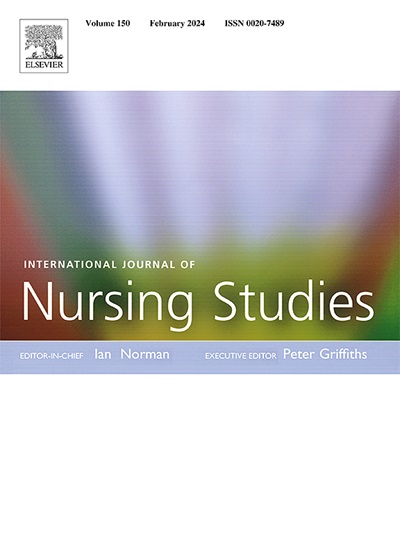Impact of noise exposure during emergence on acute pain after orthopedic surgery: A prospective observational study
IF 7.1
1区 医学
Q1 NURSING
引用次数: 0
Abstract
Background
Noise exposure is common during emergence from general anesthesia, particularly after orthopedic surgery.
Objective
We aimed to evaluate the direct impact of noise in the post-anesthesia care unit on postoperative pain and analgesic requirements in patients undergoing orthopedic surgery.
Design
Prospective observational study.
Settings
This prospective observational study was conducted at a tertiary, university-affiliated teaching hospital in Chongqing, China.
Participants
A total of 288 Chinese patients who underwent elective orthopedic surgery under general anesthesia were included.
Materials and methods
After surgery, noise levels in the post-anesthesia care unit were continuously monitored. The average noise intensity and the proportion of time that environmental noise levels exceeded 70 dB were calculated. Participants were allocated to a higher noise group and a lower noise group based on noise intensity. Postoperative pain was assessed using a numerical rating scale in the post-anesthesia care unit and during the first 24 h after post-anesthesia care unit discharge. Analgesic consumption during the same period was recorded.
Results
Noise intensity was significantly associated with the maximum pain numerical rating scale in the post-anesthesia care unit (adjusted regression coefficient = 0.46; 95 % CI 0.33 to 0.713; P < 0.001). A noise threshold of 68.945 dB was identified as the optimal cut-off value for predicting a numerical rating scale ≥ 6. Based on this threshold, patients were categorized into a high-noise group (mean noise intensity > 68.945 dB) or a low-noise group (< 68.945 dB). The high-noise group reported significantly higher maximum pain numerical rating scale scores than those of the low-noise group during the first 12 h (P < 0.001) after post-anesthesia care unit discharge, 12–24 h (P < 0.001), and over the entire 24 h (P = 0.001). Additionally, the incidence of pain with numerical rating scale ≥ 4 within 24 h after surgery and the requirement for rescue analgesia were both significantly higher in the high-noise group than in the low-noise group.
Conclusion
For patients undergoing orthopedic surgery, increased noise exposure in the post-anesthesia care unit was associated with greater postoperative pain during anesthesia recovery, as well as higher pain intensity and increased analgesic use within 24 h after post-anesthesia care unit discharge.
一项前瞻性观察研究:骨科手术后急诊期间噪音暴露对急性疼痛的影响
背景:噪声暴露在全麻苏醒期间是常见的,特别是在骨科手术后。目的探讨麻醉后护理病房噪音对骨科手术患者术后疼痛和镇痛需求的直接影响。前瞻性观察性研究。本前瞻性观察研究在中国重庆的一所大学附属三级教学医院进行。共纳入288例全麻下择期骨科手术的中国患者。材料与方法对手术后麻醉后护理病房的噪声水平进行连续监测。计算了平均噪声强度和环境噪声超过70 dB的时间比例。参与者根据噪音强度被分配到高噪音组和低噪音组。术后疼痛在麻醉后护理病房和麻醉后护理病房出院后的前24小时内使用数值评定量表进行评估。记录同期镇痛药的使用情况。结果麻醉后护理单元噪音强度与最大疼痛数值评定量表显著相关(校正回归系数= 0.46;95% CI = 0.33 ~ 0.713; P < 0.001)。噪声阈值68.945 dB是预测数值评定量表≥6的最佳临界值。根据该阈值将患者分为高噪声组(平均噪声强度>; 68.945 dB)和低噪声组(< 68.945 dB)。在麻醉后护理单元出院后的前12小时(P < 0.001)、12 - 24小时(P < 0.001)和整个24小时(P = 0.001),高噪音组报告的最大疼痛数值评定量表评分显著高于低噪音组。此外,高噪声组术后24 h内数值评定量表≥4级疼痛发生率及对抢救性镇痛的需求均显著高于低噪声组。结论对于骨科手术患者,麻醉后护理病房噪音暴露的增加与麻醉恢复期间术后疼痛加重有关,麻醉后护理病房出院后24 h内疼痛强度和镇痛药物使用增加有关。
本文章由计算机程序翻译,如有差异,请以英文原文为准。
求助全文
约1分钟内获得全文
求助全文
来源期刊
CiteScore
15.00
自引率
2.50%
发文量
181
审稿时长
21 days
期刊介绍:
The International Journal of Nursing Studies (IJNS) is a highly respected journal that has been publishing original peer-reviewed articles since 1963. It provides a forum for original research and scholarship about health care delivery, organisation, management, workforce, policy, and research methods relevant to nursing, midwifery, and other health related professions. The journal aims to support evidence informed policy and practice by publishing research, systematic and other scholarly reviews, critical discussion, and commentary of the highest standard. The IJNS is indexed in major databases including PubMed, Medline, Thomson Reuters - Science Citation Index, Scopus, Thomson Reuters - Social Science Citation Index, CINAHL, and the BNI (British Nursing Index).

 求助内容:
求助内容: 应助结果提醒方式:
应助结果提醒方式:


